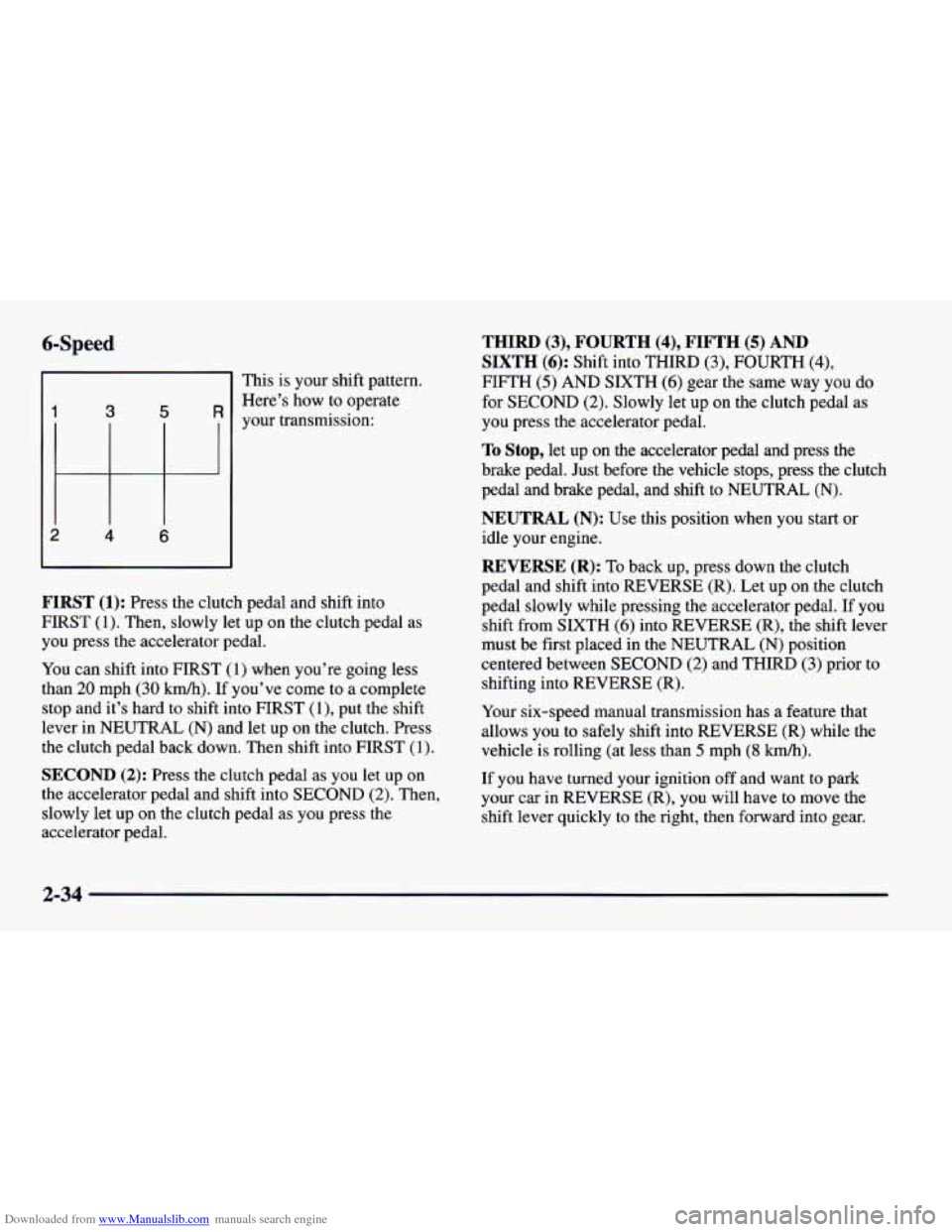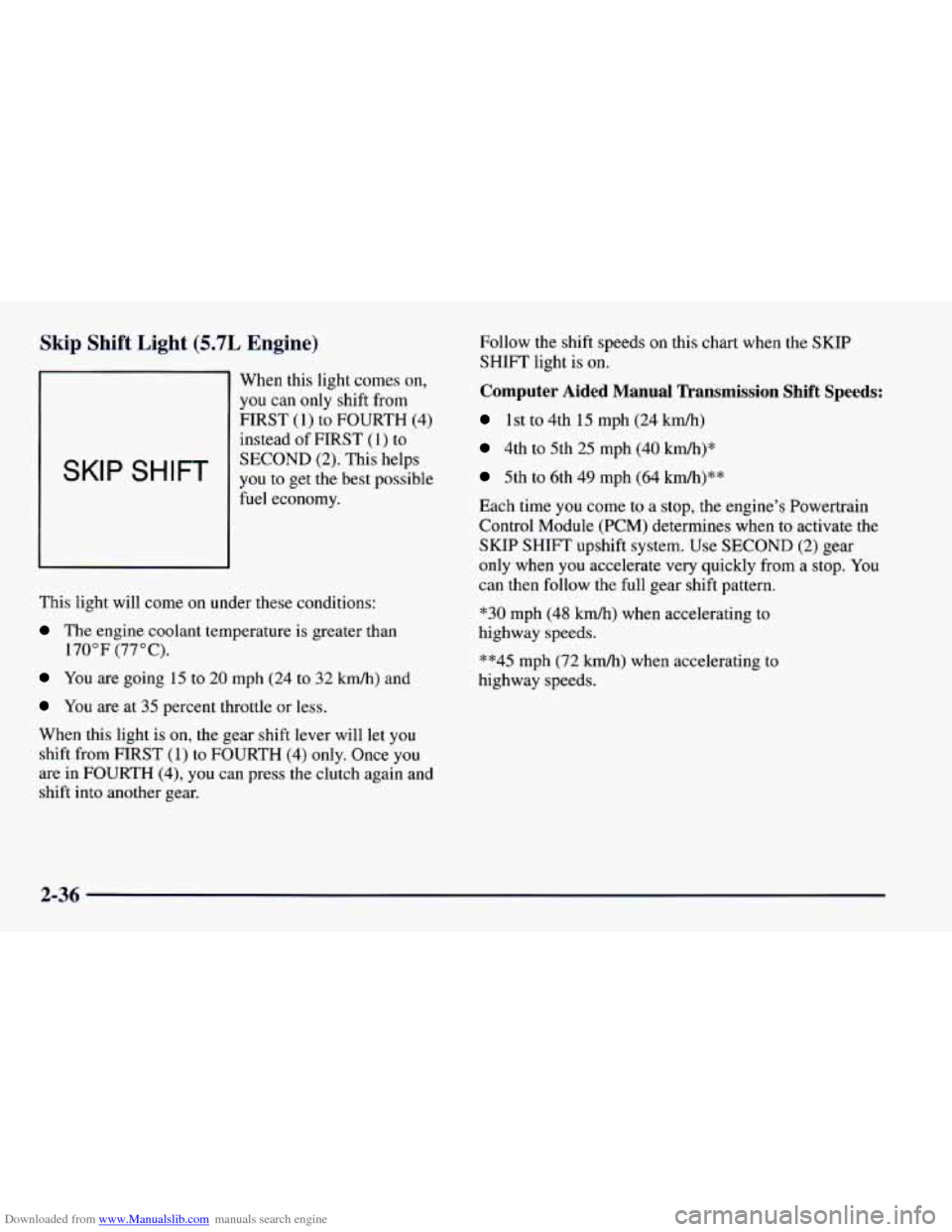1997 CHEVROLET CAMARO clutch
[x] Cancel search: clutchPage 76 of 404

Downloaded from www.Manualslib.com manuals search engine Starting Your Engine
Automatic Transmission
Move your shift lever to PARK (P) or NEUTRAL (N).
Your engine won’t start in any other position -- that’s a
safety feature. To restart when you’re already moving,
use NEUTRAL (N) only.
NOTICE:
Don’t try to shift to PARK (P) if your Chevrolet
is moving.
If you do, you could damage the
transmission. Shift to PARK
(P) only when your
vehicle
is stopped.
Manual Transmission
The gear selector should be in NEUTRAL (N). Hold the
clutch pedal to the floor and start the engine. Your
vehicle won’t start if the clutch pedal is not
all the way
down
-- that’s a safety feature. 1.
Without pushing the accelerator pedal, turn your
ignition key
to START. When the engine starts, let
go of the key. The idle speed will go down as your
engine gets warm.
I NOTICE:
Holding your key in START for longer than
15 seconds at a time will cause your battery to be
drained much sooner. And the excessive heat can
damage your starter motor.
2. If it doesn’t start right away, hold your key in
START for about three to five seconds at a time until
your engine
starts. Wait about 15 seconds between
each try to help avoid draining your battery.
3. If your engine still won’t start (or starts but then stops),
it could be flooded with too much gasoline. Try
pushing your accelerator pedal all the way to the floor
and holding it there as
you hold the key in START for
about
three seconds. If the vehicle starts briefly but
then stops again, do the
same thing, but this time keep
the pedal down for five or six seconds. This clears the
extra gasoline
fkom the engine. After waiting about
15 seconds, repeat the normal starting procedure.
2-26
Page 82 of 404

Downloaded from www.Manualslib.com manuals search engine NOTICE:
If your rear wheels can’t rotate, don’t try to
drive. This might happen if you were stuck in
very deep sand
or mud or were up against a solid
object.
You could damage your transmission.
Also, if you stop when going uphill, don’t hold
your vehicle there with only the accelerator
pedal. This could overheat and damage the
transmission. Use your brakes or shift into
PARK (P) to hold your vehicle in position
on
a hill.
Maximum engine speed is limited to protect driveline
components from improper operation.
Manual Transmission
5-Speed
1 3 5
This is your shift pattern.
Here’s how to operate
your transmission:
2 4 R
First (1): Press the clutch and shift into FIRST (1).
Then, slowly let up on the clutch pedal as you press the
accelerator pedal.
You can shift into FIRST (1) when you’re going less
than
20 mph (32 kmh). If you’ve come to a complete
stop and it’s hard
to shift into FIRST (l), put the shift
lever in
NEUTRAL (N) and let up on the clutch. Press
the clutch pedal back down. then shift into FIRST
(1).
2-32
Page 83 of 404

Downloaded from www.Manualslib.com manuals search engine SECOND (2): Press the clutch pedal to the floor as you
let
up on the accelerator pedal and shift into SECOND (2).
Then, slowly let up on the clutch pedal as you press the
accelerator pedal.
THIRD (3), FOURTH (4) AND FIFTH (5): Shift into
THIRD
(3), FOURTH (4) and FIFTH (5) the same way
you do for SECOND
(2). Slowly let up on the clutch as
you press the accelerator pedal.
To Stop, let up on the accelerator pedal and press the
brake pedal.
Just before the vehicle stops, press the clutch
pedal and brake pedal, and
shift to NEUTRAL (N).
NEUTRAL (N): Use this position when you start or
idle your engine.
REVERSE (R): To back up, press down the clutch
pedal and shift into REVERSE
(R). Let up on the clutch
pedal slowly while pressing the accelerator pedal.
NOTICE:
Shift to REVERSE (R) only after your vehicle is
stopped. Shifting to REVERSE
(R) while your
vehicle
is moving could damage your
transmission.
Also use REVERSE (R), along with the parking brake,
for parking your vehicle.
2-33
Page 84 of 404

Downloaded from www.Manualslib.com manuals search engine 6-Speed
This is your shift pattern.
Here’s how to operate
your transmission:
1 3 5 R
2 4 6
FIRST (1): Press the clutch pedal and shift into
FIRST (1). Then, slowly
let up on the clutch pedal as
you press
the accelerator pedal.
You can shift into FIRST (1) when you’re going less
than
20 mph (30 kmh). If you’ve come to a complete
stop and it’s hard to shift into FIRST (l), put the shift
lever in NEUTRAL
(N) and let up on the clutch. Press
the clutch pedal back down. Then shift into FIRST (1).
SECOND (2): Press the clutch pedal as you let up on
the accelerator pedal and shift into SECOND
(2). Then,
slowly let up on the clutch pedal as you press the
accelerator pedal.
THIRD (3), FOURTH (4), FIFTH (5) AND
SIXTH (6): Shift into THIRD (3), FOURTH (4),
FIFTH (5) AND SIXTH (6) gear the same way you do
for SECOND (2). Slowly let up on the clutch pedal as
you press the accelerator pedal.
To Stop, let up on the accelerator pedal and press the
brake pedal. Just before the vehicle stops, press the clutch
pedal and brake pedal, and shift to NEUTRAL (N).
NEUTRAL (N): Use this position when you start or
idle your engine.
REVERSE (R): To back up, press down the clutch
pedal and shift into REVERSE
(R). Let up on the clutch
pedal slowly while pressing the accelerator pedal. If you
shift from SIXTH
(6) into REVERSE (R), the shift lever
must be first placed in the NEUTRAL
(N) position
centered between SECOND
(2) and THIRD (3) prior to
shifting into REVERSE
(R).
Your six-speed manual transmission has a feature that
allows you to safely shift into REVERSE
(R) while the
vehicle is rolling (at less than
5 mph (8 km/h).
If you have turned your ignition off and want to park
your car
in REVERSE (R), you will have to move the
shift lever quickly to the right, then forward into gear.
2-34
Page 85 of 404

Downloaded from www.Manualslib.com manuals search engine f’ iff lpeeds
A CAUTION:
If you skip more than one gear when you
downshift, you could lose control of your vehicle.
And you could injure yourself or others. Don’t
shift from SIXTH
(6) to THIRD (3), or FIFTH (5)
to SECOND (2) or FOURTH (4) to FIRST (1).
MANUAL TRANSMISSION RECOMMENDED SHIFT SPEEDS, IN MPH (kmlh) I I
Engine Acceleration Shift Speed
It02 I 2to3 I 3to4 I 4105 I 5to6
This chart shows when to shift to the next higher gear
for best fuel economy.
If your speed drops below 20 mph (30 km/h), or if the
engine is not running smoothly, you should downshift
to
the next lower gear. You may have to downshift two or
more gears to keep the engine running smoothly
or for
good performance.
NOTICE:
If you skip more than one gear when you
downshift, or if you race the engine when you
downshift, you can damage
the clutch
or transmission.
2-35
Page 86 of 404

Downloaded from www.Manualslib.com manuals search engine Skip Shift Light (5.7L Engine)
When this light comes on,
you can only shift from
FIRST (1) to FOURTH (4)
instead
of FIRST (1) to
SECOND (2). This helps
you to get the best possible
fuel economy.
This light will come on under these conditions:
The engine coolant temperature is greater than
170°F (77°C).
You are going 15 to 20 mph (24 to 32 km/h) and
You are at 35 percent throttle or less.
When this light is on, the gear shift lever
will rer you
shift from FIRST (1) to FOURTH (4) only. Once you
are in
FOURTH (4), you can press the clutch again and
shift into another gear. Follow
the shift speeds
on this chart when the SKIP
SHIFT light is on.
Computer Aided Manual Transmission Shift Speeds:
1st to 4th 15 mph (24 km/h)
4th to 5th 25 mph (40 km/h)*
5th to 6th 49 mph (64 km/h)**
Each time you come to a stop, the engine's Powertrain
Control Module (PCM) determines when to activate the
SKIP SHIFT upshift system. Use
SECOND (2) gear
only when you accelerate very quickly from a stop.
You
can then follow the full gear shift pattern.
"30 mph (48 km/h) when accelerating to
highway speeds.
**45 mph (72 km/h) when accelerating to
highway speeds.
2-36
Page 98 of 404

Downloaded from www.Manualslib.com manuals search engine Cruise Control
a[ With cruise control,
Ti
you can maintain a
speed
of about 25 mph
(40 kmh) or more
without keeping your
foot on the accelerator. ., ,‘
This can really help on long trips. Cruise control does
not work at speeds below about
25 mph
(40 kmh).
When
you apply your brakes, or push the clutch pedal,
if you have a manual transmission, the cruise control
shuts
off.
Cruise control can be dangerous where you
can’t drive safely at
a steady speed. So,
don’t use your cruise control on winding
roads or in heavy traffic.
slippery roads. On such roads, fast changes in tire traction can cause needless wheel
spinning, and you could lose control. Don’t
use cruise control on slippery roads.
Cruise control can be dangerous on
I I
If your vehicle is in cruise control when the optional
ASR system begins to limit wheel spin, the cruise
control will automatically disengage. (See
“ASR
System” in the Index.) When road conditions allow you
to safely use it again, you may turn the cruise control
back
on.
2-48
Page 100 of 404

Downloaded from www.Manualslib.com manuals search engine Resuming a Set Speed
Suppose you set your cruise control at a desired speed
and then apply the brake or clutch pedal. This, of course,
shuts off the cruise control. But
you don’t need to reset
it. Once you’re going about
25 mph (40 km/h) or more,
you can move the cruise control switch from
ON to
R/A (Resume/Accelerate) for about half a second.
You’ll
go right back up to your chosen speed and
stay there.
Increasing Speed While Using Cruise Control
There are two ways to go to a higher speed:
0 Use the accelerator pedal to get to the higher speed.
Push the button at the end of the lever, then release
the button and
the accelerator pedal. You’ll now
cruise at the higher speed.
Move the cruise switch from ON to R/A. Hold it
there until you get up
to the speed you want, and
then release the switch.
(To increase your speed in
very small amounts, move the switch to
R/A for
less than half a second and then release it. Each
time you do this, your vehicle will go about
1 mph
(1.6 km/h) faster.)
2-50